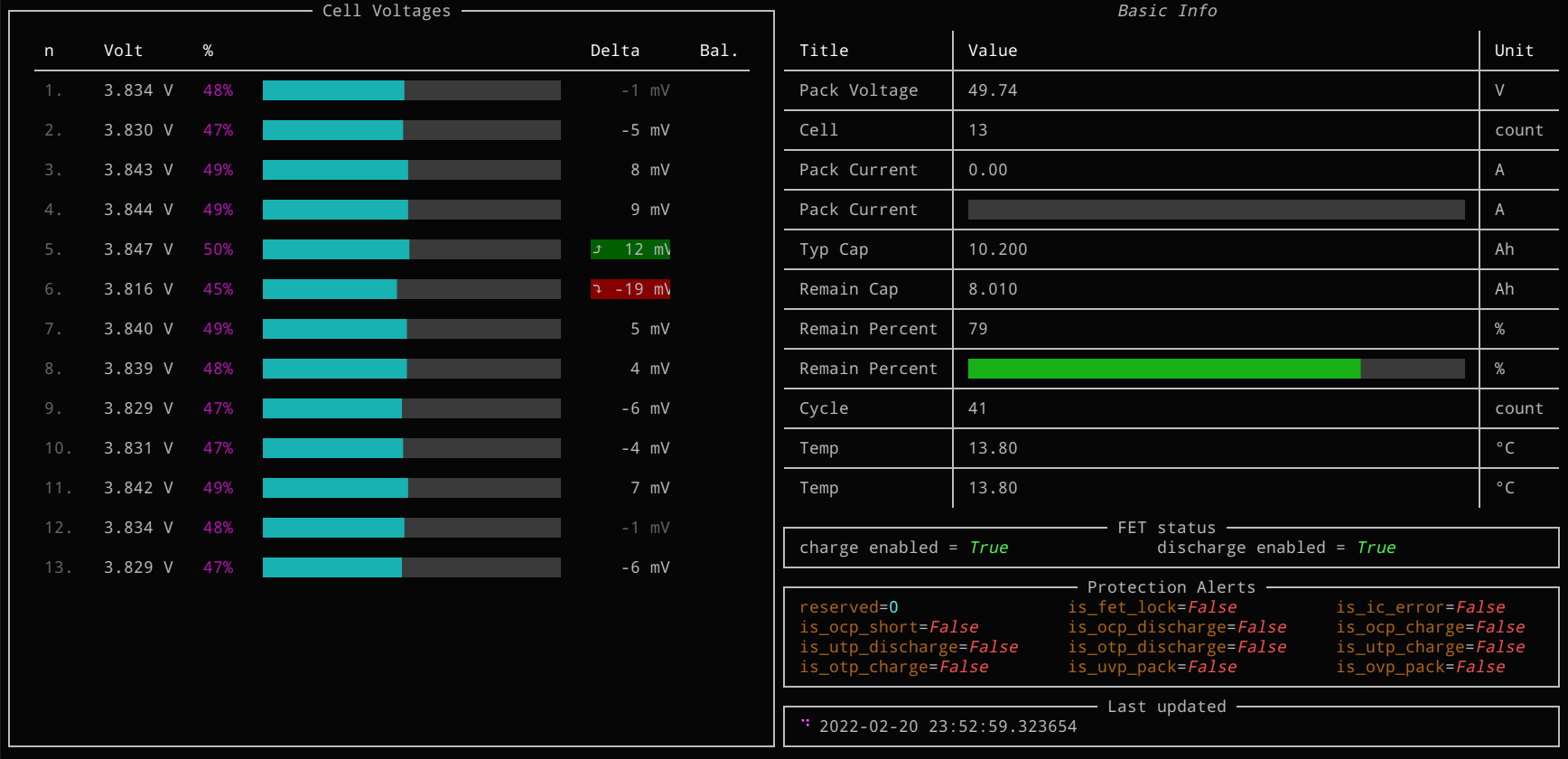Decoding the Smart BMS Protocol
Smart (meaning with UART / Bluetooth interface) battery management systems are widely available from china now. Almost all of them use a generic protocol for the communication. They also provide a (Windows) PC Software and Android App, which works fine, but I like to add more features and make it open source. So I wrote the protocol definition in Kaitai Struct, a specific parsing language with YAML syntax, which can be compiled to parsers in many different languages like Java, C++, Python etc…
LTT Power manufactured the BMS I got and is nice enough to provide a spreadsheet with a rough description of the protocol on their download page. Following is a introduction to the binary protocol, with graphs generated also from Kaitais Graphviz export. In addition I made Sigrok protocol decoder, to make it visible with from a logic analyser capture. Everything is on GitHub in this repo.
Protocol Intro
In gerneral every packet has a start byte DD and end byte 77 (all in hex). After that comes a command code, there are a few special values: 165 = A5 is a request to read and 90 = 5A a write request. Then ID of the field/type and maybe some body data. Size numbers in the graphs are (unless otherwise specified) in byte.
For example to read the hardware info send: DD A5 05 00 FF FB 77, that is cmd ID 05 and always zero data length for read. Directly before the stop byte are 2 bytes checksum (how to calculate these later).
The BMS responds with: DD 05 00 11 53 50 31 35 53 30 30 31 2D 50 31 33 53 2D 33 30 41 FB FD 77, again indicating that is cmd/type/field 05, next one byte status (00 is ok). A byte with data length and the data follows, in this type a 17 byte long (ascii) string.
Besides the simple hardware request are the IDs 04 for reading the individual cell voltages and 03 for various informations. Data in cell voltages contains just the numbers sequentially, 2 bytes per cell. For example 0E E6 = 3814 mV. Therefore a 13S pack gives 26 byte of data.
Probably the most import is 03 basic info. It contains the total pack voltages, actual current, remaining and typical capacity, this time in 10 mV/mA/mAh units, so multiply with 0.01 to get standard SI units. 4 byte are reserved for balancing flags, size 1b means one bit per cell. If the bit is set the cell is currently balancing. ProtList contains various error conditions where the protection kicked in, should usually be all zero. FetBits show if the charge and discharge FET is currently enabled. At the end a variable number of temperature sensors (NTCs), the raw value is here tenths of Kelvin.
These were the standard IDs, but for configuration are many higher values included (read+write). They are not implemented is this parser, but I might add it in the future. In the Battery Monitor project (scripts to log BMS data on Linux) they started to document them.
Checksum calculation
It is basically a sum over every relevant byte and then subtract that from 2^16 (65536), the result should match the checksum in the packet. Now lets implement this in Python:
def verify(packet):
data = packet[2:-3]
check = packet[-3:-1]
Here data contains all bytes that go into the checksum calculation.
check is the 2 byte checksum of the current package, last bit is always the stop bit (0x77), so cut it off.
crc=0x10000
for i in data:
crc = crc-int(i)
crc_b = crc.to_bytes(2, byteorder='big')
return check == crc_b
It returns True if the checksums match and are therefore correct.
Sigrok Protocol Decoder
As announced in the beginning I made a sigrok BMS protocol decoder, which can be used in PulseView or DSView and a wide range of logic analyzer hardware. This is a Python module based of the compilation from my Kaitai Struct. It is in the repo under decoder/bms/ to install it for a single user move it into ~/.local/share/libsigrokdecode/decoders (or libsigrokdecode4DSL respectively).
Basic Info looks like this in DSView, showing the most important properties:

Or all the cell voltages:

Higher IDs (here 14) will not be parsed further and the data block displayed just as hex bytes:

Reuse
If someone wants to make a own application with the parser you can compile it in any of the supported target languages from the Kaitai definition. ksy files are in the repo under kaitai/. I am planning to build a Android App to log the power usage and battery status, especially for electric vehicles.
Development 2022
Mainly I added an Python based CLI tool to read out basic info and cell voltages, it has also the option to log into an Mongo DB. To run it got to \py and run python main.py /dev/ttyXXX (+ other parameters).
The best overview for live data provides the terminal UI:
 See the main repo readme for more details.
See the main repo readme for more details.